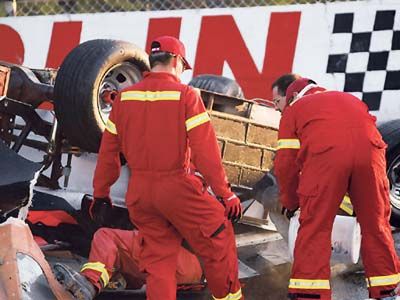
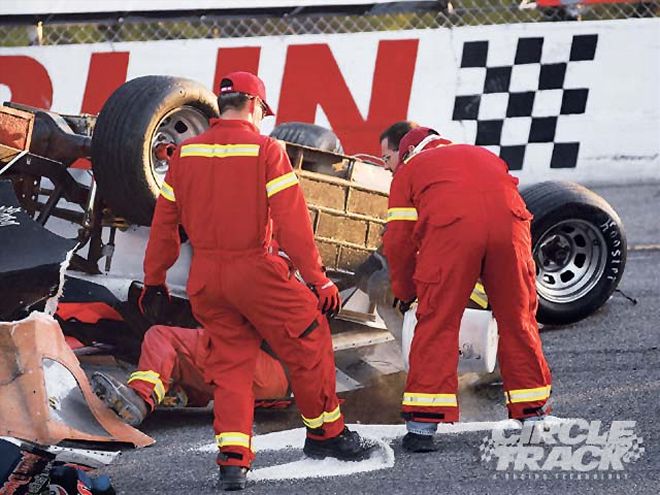 Is this the year you have the Big One? Are you protected from injury to your head and neck? With the availability of proven products to reduce the risk of injury or death in a violent frontal crash, there's no reason drivers should be without a head-and-neck restraint system.
Is this the year you have the Big One? Are you protected from injury to your head and neck? With the availability of proven products to reduce the risk of injury or death in a violent frontal crash, there's no reason drivers should be without a head-and-neck restraint system.
Every so often, something comes along that greatly increases the rate of survival related to stock car racing accidents. The first major improvement was the five point seatbelt, mostly aviation units left over from WWII. Before that, drivers didn't wear belts.
We had the introduction of the firesuit in the 1960s, then the fuel cell replaced the metal fuel containers that always split open and spilled their lethal cargo in a crash. We've seen better designed helmets, shoes, and gloves and better built race cars that help to protect the driver.
The most significant leap in safety technology during the past 20 years has been the development and implementation of the head-and-neck restraint systems. Looking back over the course of time, we find that a great number--maybe most--of drivers who lost their lives in stock car racing accidents died from "brain" injury. I quoted that word because it's a little misleading.
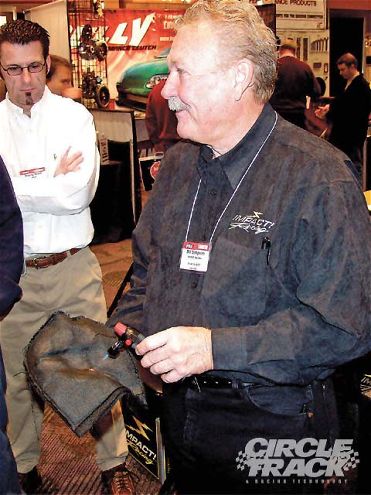 It's a fact that Bill Simpson pioneered the manufacturing and implementation of racing firesuits. He set himself on fire at Indy to prove the point that drivers can survive fiery accidents. The rest is history. The advent of the head-and-neck restraint systems ranks right up there with firesuits as a major leap in racing safety.
It's a fact that Bill Simpson pioneered the manufacturing and implementation of racing firesuits. He set himself on fire at Indy to prove the point that drivers can survive fiery accidents. The rest is history. The advent of the head-and-neck restraint systems ranks right up there with firesuits as a major leap in racing safety.
When I heard the term, "brain injury," I always thought it meant the brain was bruised or damaged in some way inside the skull. That may still have occurred, but what really killed many drivers who impacted concrete walls, or other immoveable objects, is a little different. It involved the violent forward motion of the unrestrained head when the car stops suddenly. Up to this point, we've done a good job of restraining the body of the driver with wraparound seats and five- and six-point belts, but what about the head?
I grew up in Daytona, a lucky coincidence, and used to regularly visit the big track. Aided by my father being a local telephone worker, he could always get the highest level passes for whatever was going on out at the track. One day around 1965 I heard some more experienced NASCAR drivers talking to a few rookies about what to do in the event of a crash. The speeds there were approaching 180 mph and these cars were very similar to glorified strictly stock classers that now run at the local half-mile track.
The older drivers told the rookies that when it was imminent that you were going to go head first into the wall, you should move forward into the belts and tuck your head down against the steering wheel. The point was, you're going to go forward anyway and it's best to be tight against the belt rather than fly forward and strike the belt.
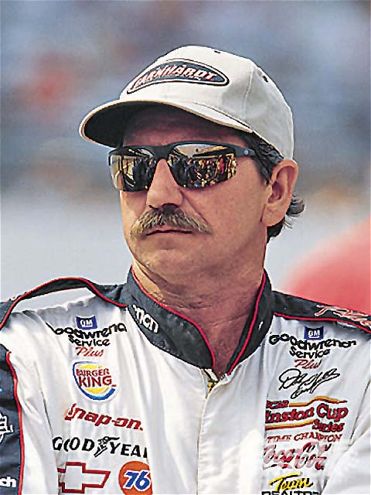 Would Dale still be here with us if he had worn a head-and-neck restraint? No one can answer that. What I do know is that this one racing-world changing event caused an uproar that sent ripples throughout the racing community and motivated the governing bodies to enact changes that have proven to be effective in reducing the risk of driving a race car. I for one believe his death has ultimately saved so many of his fellow racers. I still miss him.
Would Dale still be here with us if he had worn a head-and-neck restraint? No one can answer that. What I do know is that this one racing-world changing event caused an uproar that sent ripples throughout the racing community and motivated the governing bodies to enact changes that have proven to be effective in reducing the risk of driving a race car. I for one believe his death has ultimately saved so many of his fellow racers. I still miss him.
The head, inside the helmet, being put against the steering wheel created a restraint whereby the wheel absorbed the impact and restrained the head, much like the current breed of head-and-neck restraints. That, my friends, is why many stock car drivers going 180 mph, and upwards of 210 mph later on, survived high-impact crashes at Daytona. We can do much better now.
One of the things that I really like about my job is that I get to inform racers about how to better enjoy this sport, and more so, how to survive it. Read on and take this information to heart. It's probably the most important thing you can learn in your entire career.
Some Crash Facts We've previously researched the leading suppliers of head-and-neck restraints and also the SFI Foundation to nail down the specifics of head and neck injury dynamics. We wanted to know where the threshold lies between survivability and injury in relation to speed versus impact. Here's what we found.
The SFI certifies safety equipment for racing. The following was copied from its website: "The SFI Foundation Inc. (SFI) is a non-profit organization established to issue and administer standards for specialty and performance automotive and racing equipment." Many top sanctioning bodies require SFI certification for driver suits, helmets, and more, including head-and-neck restraints.
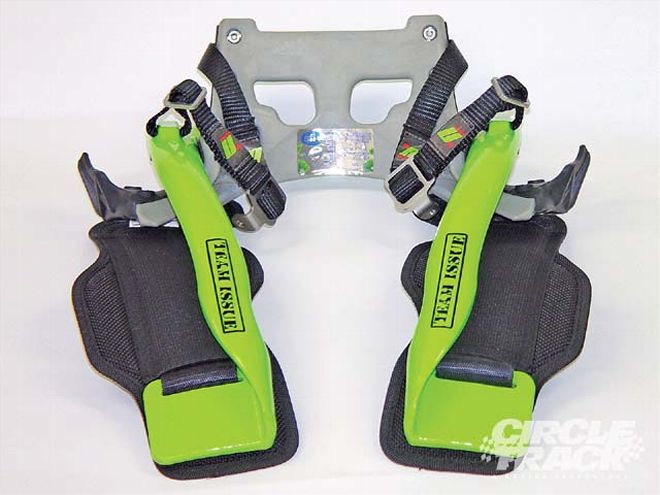 DefNder's unique design incorporates flexible form-fit belts and a stabilizer bar chassis design that offers drivers unparalleled comfort.
DefNder's unique design incorporates flexible form-fit belts and a stabilizer bar chassis design that offers drivers unparalleled comfort.
According to our sources, the threshold established for preventing serious injury to the head and neck begins at and above 4,000 Newtons (N). One pound of force is equal to 4.4 N. This would be about 5 g's on the entire body of a person who weighs 180 pounds. The SFI testing level is 70 g's. For a force exerted on the base of the skull and neck, that's equal to the weight of the head (including the helmet, and so on) multiplied by 70. The head and neck can't physically contain such a force if unprotected. The damage is similar to what happens when someone gets hanged. It's not a pretty sight.
The ultimate force necessary to cause injury in each person is necessarily dependent on varying factors that make choosing a threshold difficult. The following are factors that enter into the complex circumstances of crash survival: 1) the driver's age (the younger the better), 2) the driver's weight, especially the head, 3) how physically fit the driver is, 4) the driver's gender (you pick which is better), and 5) past injuries that may contribute to the degree of injury in later events. So, choosing a threshold such as 4,000 N doesn't necessarily indicate a perfectly safe condition--it just indicates that you're much better off if a device can lower the force on the head and neck to some force below that level.
"Without" Results Without an H&N device, the forces on the head and neck can exceed 35 g's in a 60mph crash. The SFI test level force of 70 g's is probably much higher than we will ever experience but it's possible. The various devices being tested must lower the force felt at the base of the skull to well below the 4,000 N level (909 pounds of force).
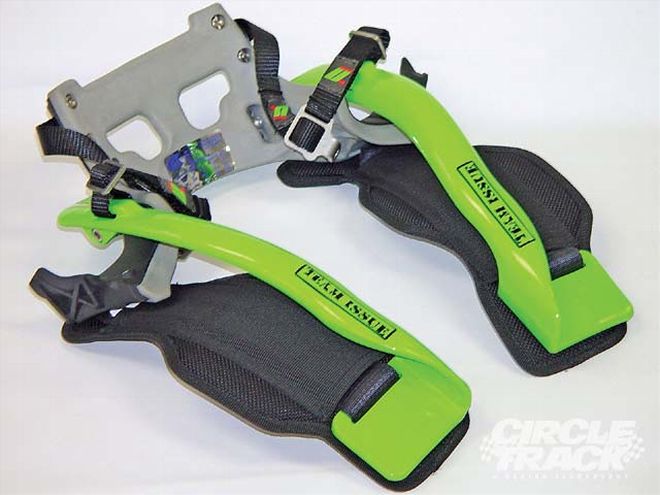 DefNder's Motion-Max incorporates VST geometry which acts as a stabilizer in side-impact scenarios. This is also the same system that allows you the freedom of turning your head left to right.
DefNder's Motion-Max incorporates VST geometry which acts as a stabilizer in side-impact scenarios. This is also the same system that allows you the freedom of turning your head left to right.
Getting down to brass tacks, what does that mean? It's all dependent on the amount of head weight plus helmet weight. We found this interesting quote on the SFI website: "An adult human cadaver head cut off around vertebra C3, with no hair, weighs somewhere between 4.5 and 5 kg, constituting around 8 percent of the whole body mass." In our 180-pound example, the head would weigh about 15 pounds. A helmet weighs about 31?2 pounds. So, if we divide 909 pounds of force (4,000 N) by 18.5, that equals about 50 g's.
This may indicate that a 180-pound person will not survive a crash that exceeds 50 g's, according to the 4,000 N limit. In reality, the actual force of a sudden impact may far exceed 4,000 N because of the whipping effect of the head being thrown forward on impact. So, a 35g crash, measured in the car, may instantaneously exert more force than that on the head and neck, hence the 70g test level.
A heavier head/helmet combination would necessitate the need to experience even less g-force in a crash in order to survive. We can see where g-force and Newton numbers are subjective. The bottom line is that we need to reduce the loads on our head and neck in order to survive a crash. Head-and-neck restraint systems do just that. Racing without one is like walking on a tightrope with a noose around your neck. If you fall off, well, you get the point.
Product Showcase In a typical race car, the driver's body is restrained by the seatbelts and seat. This leaves the head free to move unrestrained in the event of an impact. This unrestrained movement can lead to injury and, in many cases, death. Head-and-neck restraints have been developed to combat this.
Recent racing history tells us there is a real and present danger to the driver associated with sudden deceleration when crashing into concrete walls or other objects at high speeds. In addition to the rash of top-level professional drivers' deaths, of which we are all aware, there have been fatalities on the short tracks caused by the very same conditions that these products are designed to address.
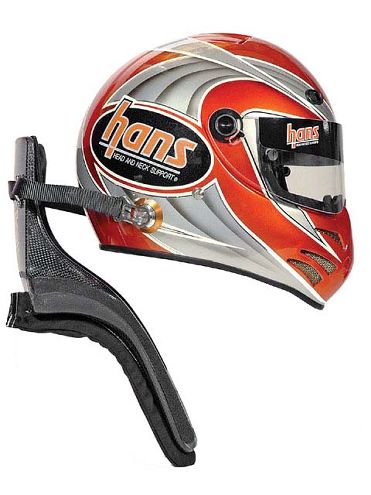 The HANS Device reduces thewhipping action of the head, keeping the driver's head from being pulled away from the upper body. With a HANS, the forces stretching the neck in a frontal collision are typically reduced by 80 percent.
The HANS Device reduces thewhipping action of the head, keeping the driver's head from being pulled away from the upper body. With a HANS, the forces stretching the neck in a frontal collision are typically reduced by 80 percent.
Several companies have addressed this safety issue and developed products that reduce the risk of serious injury in a frontal and near-frontal crash. If you don't have or use a head-and-neck restraint system, it's time for you to think about purchasing one before you actually need one. Let's take a look at what's out there.
DefNder Neck Brace The defNder Team Issue head-and-neck device addresses the issues of comfort and price while still offering the needed protection. DefNder's philosophy behind its head-and-neck device is to offer all race drivers the opportunity to have the best and most-comfortable high-performance protection against neck injury at an affordable price.
While it may look similar to other HNR devices on the market, defNder's unique design incorporates flexible form-fit belts and a stabilizer bar chassis design that offers drivers unparalleled comfort. The design of the system allows you to put it on straight over your head, just as you would your helmet, and gives you complete freedom of mobility by allowing you to turn your head to the left and right.
Through numerous sled runs conducted by Delphi, the device easily achieved the SFI 38.1 certification for HNRs. In this exceptional 70g sled test, the defNder's figures were very consistent in both frontal and 30-degree tests, a testament to the significant amount of emphasis defNder's design team placed on side-impact protection. The same defNder withstood multiple sled runs without a single failure.
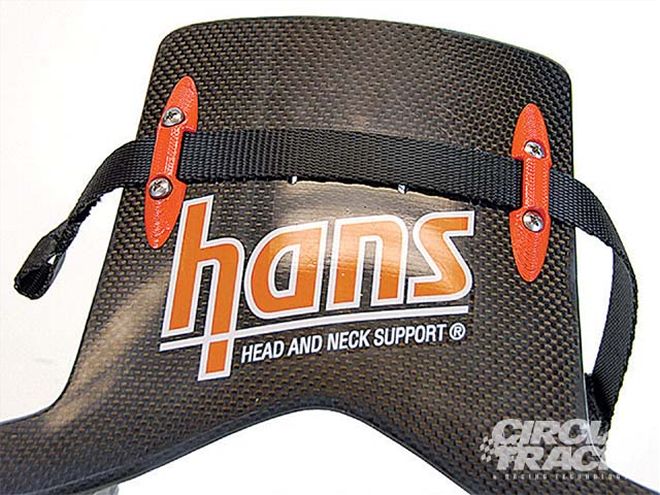 The new Vision Advantage PLUS sliding tether system from HANS allows a full range of head motion under normal race conditions and provides the same impact performance.
The new Vision Advantage PLUS sliding tether system from HANS allows a full range of head motion under normal race conditions and provides the same impact performance.
Constructed from high-performance injection composites, the defNder features the highest grade hardware and technically advanced nylon in its Motion-Max tether system, the heart of the side-impact protection. Motion-Max incorporates VST geometry which acts as a stabilizer in side-impact scenarios. This is also the same system that allows you the freedom of turning your head left to right.
A big plus in the design of the defNder is the harness flares which locate your safety belts and keep the device from sliding around. DefNder says you can easily exit your vehicle in an emergency situation, so, we climbed in and out of our Dirt Late Model with it on just to test that statement. You can, no kidding. However, after testing the device in the shop, our favorite feature has to be the Real-eaze quick release system. This system allows the driver to put on and take off this head-and-neck restraint by himself, a true single-person operation.
Hans Device Jim Downing and Bob Hubbard started making and selling HANS Devices in 1990, before the broader racing community really understood much about the biomechanics and significance of head-and-neck injuries. In 1997, they started developing the current version. These new devices are smaller and lighter and fit a broad spectrum of racers and cockpits.
Long before that, they saw a need. From their perspectives as race car drivers and biomechanical experts, they recognized in the early '80s that racers were receiving serious head injuries in crashes that might otherwise be injury free. With extensive racing experience, studies in skull bone strength, and data from crash test dummies, they designed the HANS Device to function so that when a racer's torso is restrained, the device restrains the head from swinging forward, thus greatly reducing neck loads.
The basic concept is this. In a crash without a HANS Device, the shoulder harness and seatbelt restrain the driver's torso, but only the neck restrains the head and helmet. The HANS Device reduces the whipping action of the head, keeping the driver's head from being pulled away from the upper body. With a HANS, the forces stretching the neck in a frontal collision are typically reduced by 80 percent. In a frontal impact, the tethers restrain the head's forward movements while the torso and HANS Device are restrained by the shoulder harnesses.
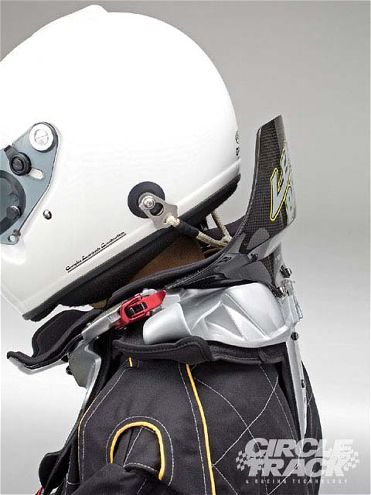 The Leatt-Brace is an injection-molded, glass reinforced nylon or carbon-fiber and Kevlar neck-brace system designed by medical professionals and motorcycle enthusiasts.
The Leatt-Brace is an injection-molded, glass reinforced nylon or carbon-fiber and Kevlar neck-brace system designed by medical professionals and motorcycle enthusiasts.
By restraining the head to move with the torso in a crash, excessive head motions, neck forces, and injuries are dramatically reduced. Many racers credit the HANS with helping them to continue racing and for saving their lives. The HANS Device has been built to industry standards, including those of the SFI and the FIA and is approved by the FIA, NASCAR, and the NHRA among other sanctioning groups worldwide.
The new Vision Advantage PLUS sliding tether system from HANS has been shortlisted for the 2008 Safety Innovation of the Year Award. The sliding tether system allows a full range of head motion under normal race conditions and provides the same impact performance. The Vision Advantage PLUS sliding tether system permits improvements in left and right visibility by allowing easy but controlled rotation of a racer's helmet. The proven results are tethers that allow a much greater field of vision.
Leatt Brace
The Leatt-Brace is an injection molded, glass reinforced nylon or carbon-fiber and Kevlar neck-brace system designed by medical professionals and motorcycle enthusiasts to help prevent:
Hyperflexion: extreme forward head movement.
Hyperextension: extreme rearward head movement.
Lateral Hyperflexion: extreme sideways head movement.
Axial loading: compression of the spinal column due to the effect of force on the helmet.
Posterior hypertranslation: rearward movement of the head on the neck.
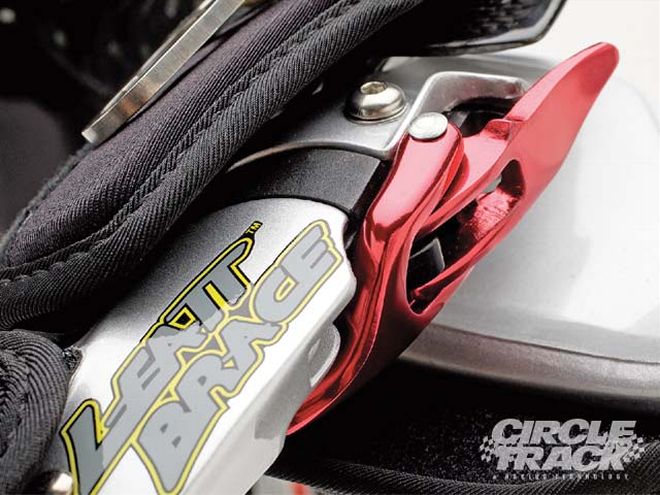 The Leatt-Brace doesn't require any equipment modification and is compatible with most helmet, safety harness, and seat combinations. It doesn't rely on the safety harness only to be effective and keeps the safety harness away from the soft tissue neck structures. At the same time, it allows the belts to fit more comfortably. The brace is also compatible with open-faced helmets and therefore used in Off Road and Rally categories.
The Leatt-Brace doesn't require any equipment modification and is compatible with most helmet, safety harness, and seat combinations. It doesn't rely on the safety harness only to be effective and keeps the safety harness away from the soft tissue neck structures. At the same time, it allows the belts to fit more comfortably. The brace is also compatible with open-faced helmets and therefore used in Off Road and Rally categories.
The Leatt-Brace allows normal driver mobility and the ability to look sideways. Delphi (70g) and other Sled Tests (SFI 38.1 accredited), High-G Drop Testing, Destruction Testing, and Accident Simulation Software were used along with other engineering design tools to achieve optimum reduction in neck forces without compromising other body dynamics.
The design rationale behind the Leatt-Brace is to bring the head to a controlled stop. This is achieved by slowing the movement of the head until it reaches a controlled stop against the padded, rigid anatomical brace perimeter. This slowed movement also reduces levels of neck tension. In addition, the Leatt-Brace doesn't restrict the driver's mobility, something that seems to be more of a concern amongst drivers than many initially thought.
The Leatt-Brace doesn't require any equipment modification and is compatible with most helmet, safety harness, and seat combinations. It doesn't rely on the safety harness only to be effective. In fact, it keeps the safety harness away from the soft tissue neck structures and at the same time allows the belts to fit more comfortably. The brace is also compatible with open faced helmets and therefore used in Off Road and Rally categories.
Conclusion Ed Coughenhour owner of PitStopUSA.com reports, "Many racers still are not wearing any head and neck restraint. This is particularly prevalent in the open-wheel Sprint Car and Midget ranks. It's crazy that these sanctioning bodies don't require mandatory head-and-neck restraint use."
No matter if you're racing Street Stocks on dirt, Legends cars, Pro-4 Modifieds, on up to Super Late Models, or any other short-track type of car, you need to protect yourself from a high g-force frontal impact. These head-and-neck restraint systems are specifically designed to help you survive those impacts. It may seem like a rare occurrence to many, but it only takes one crash to hurt you. Do the right thing by completing your safety package with a head-and-neck restraint system.